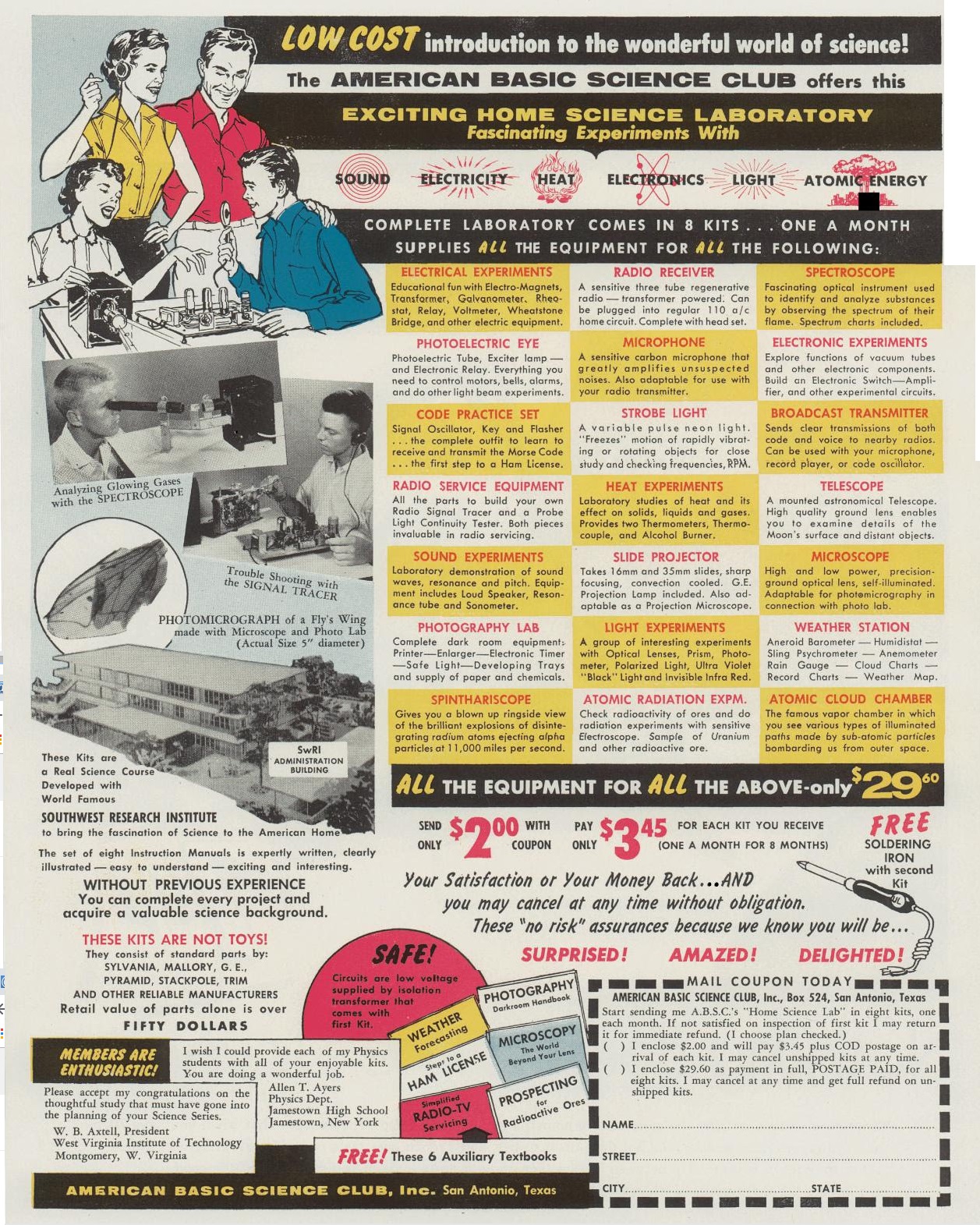 This ad for the American Basic Scientific Club appeared inside the back cover of Boys’ Life 60 years ago this month, November 1958. For only $3.45 each, the club would send one scientific kit per month for eight months, each containing an interesting project on subject such as radio, meteorology, atomic energy, and photography. At the end of eight months, the student would have a working regenerative receiver, signal tracer, code practice oscillator, darkroom (including enlarger), and many other scientific instruments.
This ad for the American Basic Scientific Club appeared inside the back cover of Boys’ Life 60 years ago this month, November 1958. For only $3.45 each, the club would send one scientific kit per month for eight months, each containing an interesting project on subject such as radio, meteorology, atomic energy, and photography. At the end of eight months, the student would have a working regenerative receiver, signal tracer, code practice oscillator, darkroom (including enlarger), and many other scientific instruments.
I don’t recall hearing about this club, which was apparently in decline by the 1970s when I would have been interested. There’s an interesting history of the club at this website, written by the son of the founder. And a picture of the three-tube regenerative receiver, along with a partial schematic, can be found at this link. The set appears to be mounted on a chassis made of a single piece of metal, mounted on the cardboard box in which the kit arrived. It does have a power transformer, making it relatively safe for the young experimenter.
One of the books included with the kits was a guide to obtaining a ham radio license. It appears that the receiver could be built for either the AM broadcast band or 80 meters, meaning that it probably made a workable receiver for a new novice.

My grandmother bought me the series in, I believe, 1958, When I was 11 years old. I can remember walking to the post office to see if the next one had come, making friends with the clerks there, and bugging them to distraction.
The chassis box (at least in my time) was a cardboard box with that yin/yang symbol on the front – it covered a hole that in later kits held a lens for optics experiments. On top of it sat a masonite board with the holes for later use punched out or drilled. First you built a power supply on the board, then later an amplifier, an oscillator and then a reciever, and probably more things – can’t remember. The second kit included a soldering iron, solder and instructions on how to use it. Near the end of the series a metal box with legs was sent to house a lamp for the spectroscope, later turned scintillation detector.
All the electronics were tube driven (transistors were very new and quite unreliable at the time). That meant that the power supply had to supply 300 volts DC for the tube plates. The kit taught about wheatstone bridge rectifiers, but supplied a single tube rectifier for the plate voltage, and a coil and electrolytic capacitor for filter. I think they may have used a diode to rectify the low voltage PS. The amplifier was two stage and drove an output transformer to a speaker.
The instruction were precise, and yet also comprehensive. It covered everything from theoretics to to the practical – why keep wires shirt and direct, why separate the power supply from the amplifier with a thin metal shield, etc., etc.
I bought those kits when I was in elementary school (early 70s) and they really set me off into a life of wonder and discovery. One of the kits was a cloud chamber; it was a plastic box that you put dry ice under, and the atomic source was a drop of radium paint on the head of a pin. These kits were pretty much my only foray into electronics with tubes (they did a lot with the 35W4), and a lot of experiments used very high voltages. I never got hurt, but I sure can’t imagine anything like this flying in today’s litigious society. But man am I ever grateful it was available to me as a kid.
I bought the kits in 1969 or 1970 and loved them. I was in high-school and already knew the science basics, but the applications and kits were fun. They expanded my school learning into fun projects. The photography kit, for example, led me to building a real darkroom with a real enlarger. I won’t say these pushed me into my science and engineering profession, but they certainly encouraged my interest.